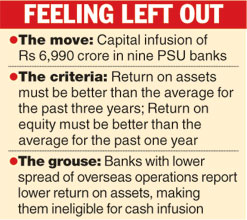IASbaba's Daily Current Affairs Analysis, IASbaba's Daily Current Affairs August 2015, International, UPSC
Archives
IASbaba’s Daily Current Affairs- 19th & 20th August, 2015
INTERNATIONAL
India – Israel ties : A close look (Analysis on WEST ASIA- Part II)
- India and Israel established full diplomatic relations in 1992 and since then the bilateral relationship between the two countries has blossomed, with defence and agriculture forming two main pillars of the bilateral agreement.
- However, in recent years, relations have seen rapid growth across a broad spectrum of areas and the future vision of the cooperation is of a strong hi-tech partnership as befits two knowledge economies.
Why Israel matters a lot to India ?
DEFENCE:
- India is the largest buyer of Israeli military equipment and Israel is the second-largest defence supplier to India after Russia.
- From 1999 to 2009, the military business between the two nations was worth around $9 billion.
- India and Israel also closely cooperate on anti-terror activities and have signed agreements, among other matters, on homeland and public security and protection of classified materials and information.
- Israel has also pledged support to the ‘Make in India’ mission in the defence sector.
AGRICULTURE:
- This has been an important facet in the Indo-Israel relationship. India has benefited from Israel’s expertise in the sector, evident from the number of bilateral agreements signed between the two nations.
- While Indian agriculture is largely dependent on rain and an erratic monsoon, Israel, a global leader in drip irrigation, has pioneered desert agriculture with sparse supplies of water.
- India has benefited from Israeli technologies in horticulture mechanisation, protected cultivation, orchard and canopy management, nursery management, micro- irrigation and post-harvest management, particularly in Haryana and Maharashtra.
- Maharashtra Chief Minister Devendra Fadnavis recently visited Israel, seeking agro-technology to address the farming crisis in the Vidarbha and Marathwada regions.
WATER MANAGEMENT:
- Technologically adept Israel has developed water-management technologies, located as it is in a semi-arid region with limited sources of fresh drinking water.
- Israel’s expertise includes recycling waste water and desalination. Indian companies and official delegations regularly visit the biannual Water Technology & Environment Control Exhibition & Conference, which showcases Israel’s water and energy technologies.
- IDE, an Israeli company, has built several desalination plants in India, including a 100-million-litre per day desalination plant at Nemelli in Tamil Nadu, commissioned in 2013, the second such plant in Chennai.
TRADE:
- India’s total trade with Israel is $6.06 billion in 2013-14, up 57% over 2009-10. The trade balance stood in India’s favour at $ 1.44 billion in 2013-14.
- Mineral fuels and oils are India’s leading export to Israel worth $1.45 billion in 2013-14.
- India’s major imports from Israel in 2013-14 included natural or cultured pearls and precious stones, worth $1.20 billion. Stones and pearls are the second-largest commodity, in terms of value, exported to Israel from India after mineral fuels.
- Israel ranks 44th in terms of foreign direct investment in India, investing $82 million between April 2000 and February 2015.
- Since 2010, the two countries have been negotiating a free-trade agreement for goods and services, which should boost investments and trade ties.
Way ahead: (Iasbaba’s view)
- Notwithstanding cooperation in agriculture, defence etc, both countries see themselves as isolated democracies threatened by neighbours that train, finance and encourage terrorism, therefore both countries also view their cooperative relationship as a strategic imperative.
Connecting the dots:
- Do you agree with the view that Israel is a “natural ally” of India ?
- Agriculture and Defence are the two pillars which determined the relationship of India with Israel. Comment.
- India needs to develop a strategic relationship with Israel ? Analyse the statement with reference to cross border terrorism in India.
ECONOMICS
Capital infusion in public sector banks
- In the past 15 years, the Government has infused more than Rs.81, 000 crore
 capitals in PSU banks but this capital is eroding due to rising bad assets.
capitals in PSU banks but this capital is eroding due to rising bad assets. - With non-performing assets of public sector banks (PSBs) soaring of late (as of the January-March quarter, gross NPAs stood at 5.20 per cent compared with 5.63 per cent in December), the Finance Ministry has announced that it will infuse Rs.70,000 crore over the next four years.
- The capital infusion will be done in three tranches – Rs 25,000 crore in this fiscal and the next followed by Rs 10,000 crore each in 2017-18 and 2018-19.
What are Non-Performing Assets (NPA’s)?
- Non-performing assets, also called non-performing loans, are loans,made by a bank or finance company, on which repayments or interest payments are not being made on time.
- A loan is an asset for a bank as the interest payments and the repayment of the principal create a stream of cash flows.
- It is from the interest payments than a bank makes its profits.
What is Capital Infusion?
- When one division is not doing well, it might benefit from an infusion of new funds from the more successful divisions.
- In the context of venture capital, it can also refer to funds received from a venture capitalist to either get the firm started or to save it from failing due to lack of cash.
How does Capital Infusion boost economy?
- Adding Capital to banks is to enable them to lend to borrowers in selected sectors such as two wheelers, consumer durable, etc, at lower rates in order to stimulate demand.
- Capital Infusion will lower the cost of lending to banks under the Marginal Standing Facility Window (MSF) to improve liquidity in the system.
- More capital to PSU banks will lower the borrowing cost and increase their capacity to lend, besides promoting investments.
Is the Rocky Road ahead for PSB’s?
- PSB executives feel that the thrust on efficiency is welcome but the timing was questionable.
- For, most state-owned banks face challenges due to big asset quality pressures, large scale retirement and a leadership gap at the top.
- Capital raising efforts by PSBs other than the capital infusion by the government face challenges because of their relatively low equity valuations compared to their private sector peers.
What does the Moody’s Report Says?
According to the Moody’s Investors Service
- The government’s plan to recapitalise public sector undertaking (PSU) banks to the tune of Rs.70, 000 crore over four years is ‘credit positive, but not a game changer’.
- Although the capital infusion plan is credit positive, we note that the capital amount is a fraction of the overall capital requirements over the next four years.
- Moody’s report does credit the government with changing the previous policy of providing capital to only select banks.
Connecting the Dots:
- “Though the capital infusion plan is credit positive, banks still need access to equity markets to materially improve their capital levels”. Explain.
- Is the money through Capital Infusion enough to take care of the capital needs, and, if it is not, how easy or difficult will it be for the public sector banks to raise money from the markets?
ENVIRONMENT
Climate Change and India- What to expect?
Note- This issue is not yet completed. We will come up with more detailed analysis after the Paris Talk. Any assumption at this stage is of less use
Background
- In December 2015, UNFCCC COP-21 or The Paris Talk is going to take place. US, China and EU have already declared their intentions and plan about emission reduction (voluntary targets). India being the fourth largest emitter is going to declare its stance later in September 2015.
What is the debate?
- From long time there is a tussle between Developed vs. Developing World on the issue of Climate Change and mitigation efforts. After failure of Kyoto Protocol and Copenhagen Summit, Paris Talk is touted to be a game changer.
- But, there are many hurdles as well as uncertainties on whether a stringent enforcement could be established or not.
The debate around India’s commitment
- India’s national scenario demands growth considering the domestic needs and requirements. Being a developing country and demand for huge population, India’s growth in industries and economy is inevitable. Consequently the emission will also increase in the process.
- India is trying its best to shift to renewable energy but major demand is fulfilled by Coal as a raw material. This is the major agenda for other developed nations. The myth of clean coal is exposed the moment USA started banking on its Shale Gas resources as earlier US was the proponent of Clean Coal Technology but now silent on this.
- India cannot give away its dependency in Coal for years to come. U.S and China have announced voluntary reduction by the end of 2030 but after reaching to peak. This is not practical for India at this point of time.
- Even if China peaks its GHG emissions by 2030, as it has committed, and the US manages to slash its emissions by 32 per cent by that year, these countries will still be spewing an estimated 14-17 tonnes of GHGs per capita. This will be more than double India’s most liberally projected carbon emission level, of seven to eight tonnes per head in 2030. At present, its per capita GHG emissions are merely 1.7 tonnes.
IASbaba’s View:
- A voluntary commitment by US and China just before Climate Talk-Paris is seen as a covert measure to avoid pressure or compulsory commitment by other nations.
- Developed countries are blaming Developing countries for the consequences of Climate Change that has direct relevance to their past wrong doings.
- Developing and Least Developing countries are demanding compensation (Loss and Damage) in the form of Funding and Technology Transfer.
- Developed world is not in favour of any compulsory fund allotment neither Transfer of Technology. They want developing countries to share the burden without any demand, mostly favouring their economy.
- There is a need to look on the greater picture of Climate Change catastrophe. All these negotiations are more of political and economic dealings unlike Environmental Concern.
- The Paris Talk should not end up like KYOTO or COPENHAGUN. Blame Game will only accelerate the issue and make it even worse.
Connecting the dots:
- “Do you think Paris Climate Talk will bring some solace to Environment”. Comment in the context of present situation.
- ‘Climate Change Negotiations have become political and economic business rather than Environmental Concern’. Do you agree?
- The whole process of Carbon Emission Reduction in itself is flawed. Critically Comment











